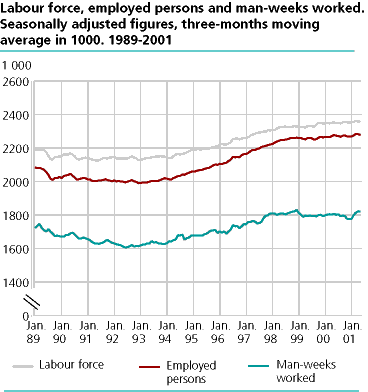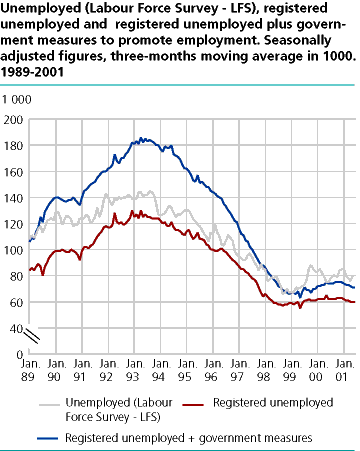Content
Published:
This is an archived release.
Stable labour force participation
The number of employed persons remained unchanged from the second quarter 2000 to the second quarter 2001. Unemployment increased by 6 000 persons, from 3.3 to 3.6 per cent, according to the Labour Force Surveys (LFS).
The proportion of economically active teenagers has decreased last year. In the second quarter 2001 52 per cent of them participated in the labour force, a decrease of one percentage point from the second quarter 2000. Among persons aged 55-66, however, the participation has increased, especially among the females.
In total employment and unemployment only small changes occurred between the first and the second quarter 2001, but there was an increase in man-weeks worked.
Compared with the second quarter 2000, there was a considerable increase in employment within business services and within health and social work. Manufacturing, agriculture, wholesale trade and motor vehicle services, on the other hand, showed a decline in employment.
Stable unemployment rate
A total of 84 000 persons were unemployed in the second quarter 2001, accounting for 3.6 per cent of the labour force, compared with 3.3 per cent the same quarter 2000. Unemployment has increased among women, but has remained unchanged among men.
The rate of long-term unemployment remained stable at 15 per cent last year. Long-term unemployed are those who have been continuously unemployed for more than six months at the time of the survey.
67 000 persons were underemployed in the second quarter 2001, i.e. part-time employed seeking more work. As a percentage of part-time employed, this corresponds to 11.4 per cent, almost the same as in the second quarter last year.
Unemployment in EU and OECD
While the seasonally adjusted unemployment rate in Norway remained unchanged at 3.4 per cent from February to May 2001, it decreased from 7.8 to 7.6 per cent as an average in the EU. The rate in the OECD-countries total remained unchanged at 6.2. In May 2001 the unemployment rate was 4.4 in USA (4.2 in February 2001), 4.6 in Denmark (4.7 in February) and 5.0 in Sweden (5.3 in February). In the Netherlands and in Luxembourg the unemployment rate was lower than in Norway.
Fewer temporary employed
There were 192 000 temporary employed in the second quarter 2001, 12 000 less than the same quarter last year. This corresponds to 9.1 per cent of all employees. The rate of temporary employment was highest in hotels and restaurants. Health and social work represented the greatest decline.
Uncertain seasonally adjusted figures
Quality tests show that the seasonally adjusted LFS unemployment figures are uncertain. The seasonal-adjustment method has problems identifying a seasonal pattern for this series of figures. The random results are relatively large compared to the seasonal component, hence one must keep in mind that the unemployment figures contain a particularly high degree of uncertainty. For more information about the seasonally adjusted figures, see a separate article.
Contact
-
Arbeidsmarked og lønn
E-mail: arbeidsmarked@ssb.no
-
Erik Herstad Horgen
E-mail: erik.horgen@ssb.no
tel.: (+47) 93 08 68 62
-
Håvard Hungnes Lien
E-mail: havard.lien@ssb.no
tel.: (+47) 40 90 26 06


